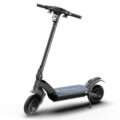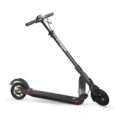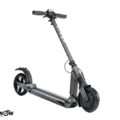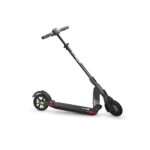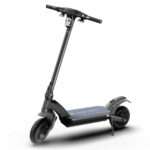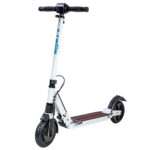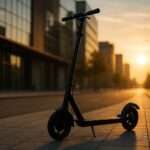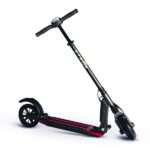- Home
- Scooters
- Electric Scooters
- E-TWOW GT Sport
E-TWOW GT Sport
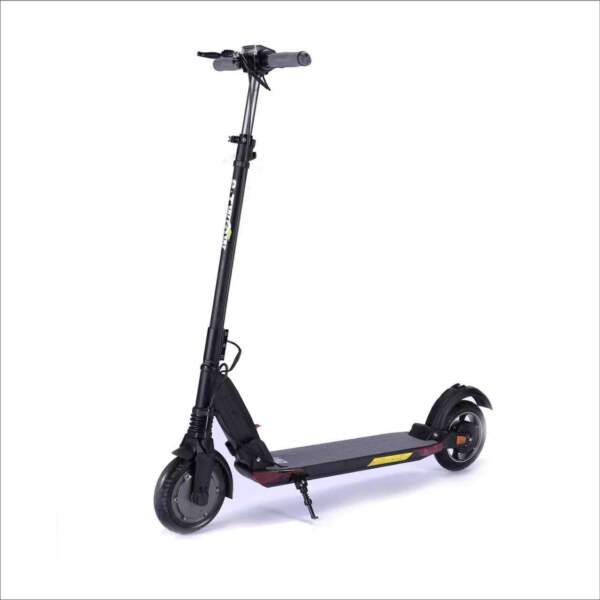


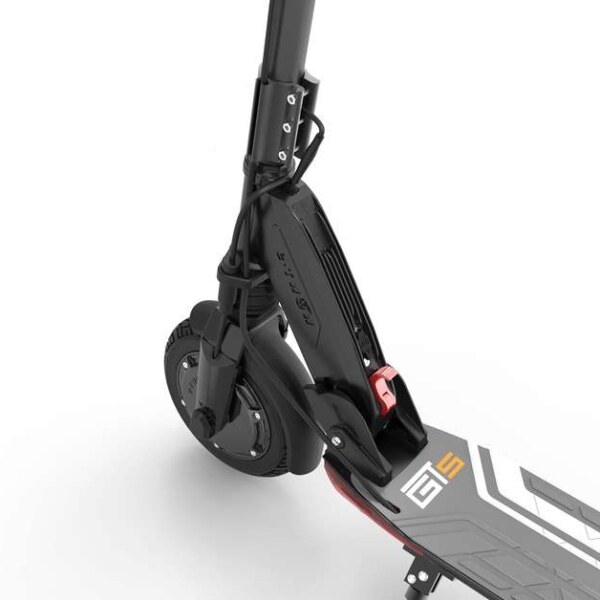
- Battery Range: 25–28 miles (40–45 km)
- Top Speed: 29 mph (46 km/h)
- Motor Power: 500 W
- Weight Capacity: 242 lb (110 kg)
- Charging Time: ~3–4 h
- Scooter Weight: 29.3 lb (13.3 kg)
PROS
- Stronger 48 V 10.5 Ah battery option
- 29 mph (46 km/h) performance in a 29 lb package
- Front regenerative + rear drum braking
- Front & rear suspension
- Bluetooth app with lock and cruise
CONS
- 8″ solid tires transmit road buzz
- IP rating not specified
- Sport mode reduces range to near 18–20 miles (30–32 km)

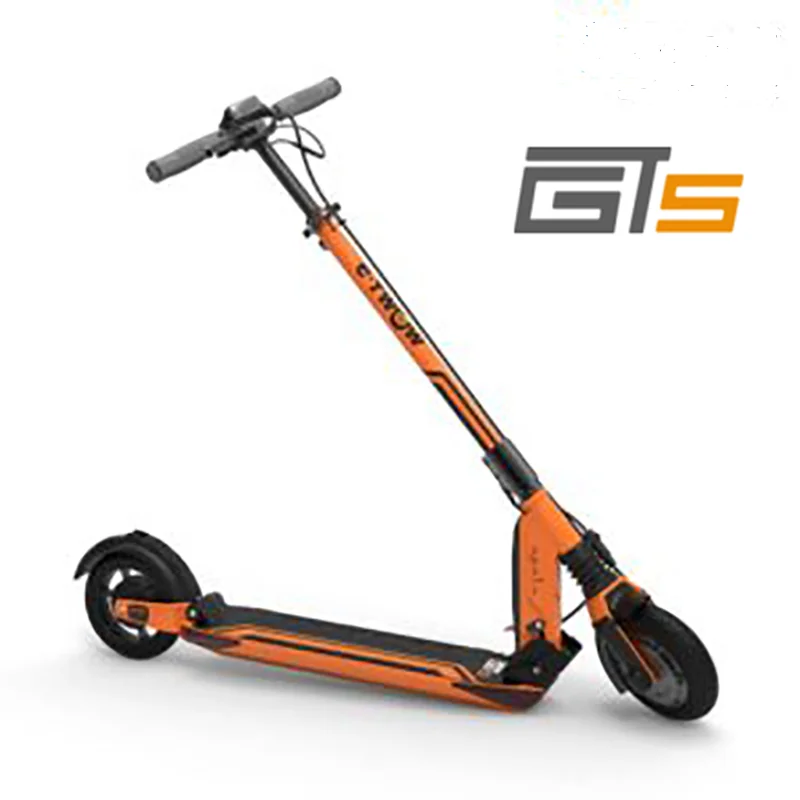


The E-TWOW GT Sport is a compact, quick, and light commuter scooter. It fits riders who want fast city trips without hauling a heavy frame. It folds small. So daily travel feels simple. If you want a calmer top end, the E-TWOW GT SL is worth a look.
What Is the E-TWOW GT Sport?
The E-TWOW GT Sport sits at the sharp end of the S2 GT line, right alongside the E-TWOW S2 GT Line. It runs a 48-volt system with a 500-watt front hub motor that peaks near 700 watts. So it pulls hard for a scooter this light. Top speed can reach about 46 km/h (29 mph) in the high setting. Claimed range lands around 40 to 45 km (25 to 28 miles) in calmer riding. Weight comes in near 13.28 kg (29.3 lb). That makes stairs and buses much easier. Stopping power comes from a strong electronic front brake plus a rear drum. The frame stays slim. Bar height adjusts for different riders. There is Bluetooth for app tweaks and quick checks.
How the E-TWOW GT Sport Works
Think of five core parts. Motor. Controller. Battery. Throttle. Brakes. Each one has a clear job.
Motor. A brushless hub motor sits in the front wheel. It delivers steady pull from a stop. So it feels eager in traffic. It holds speed well on flat roads.
Controller. This is the scooter’s brain. It meters power to the motor. It reads throttle and brake inputs. Then it sets speed modes and keeps the system safe from overheat.
Battery. The pack runs at 48 V. Capacity on recent units is 10.5 Ah with quality cells. Total energy is about 504 Wh. That size keeps punch high while the chassis stays light. Charge time with the 54.6 V charger is roughly 3 to 4 hours. Go with a 3 A brick if you need a quicker turn. Close the charge port cap when you finish.
Throttle. A right thumb lever calls for power. There is a push-to-start safety. So the scooter must roll a bit before the throttle wakes up. That prevents a surprise launch if you bump the lever.
Brakes. The left thumb lever engages strong electronic braking up front. It adds firm drag and recovers a bit of energy. A rear drum provides mechanical bite when you need it. Use both for the shortest stops. Lights and a horn round out the safety kit.
Key Specifications
| Category | Details |
|---|---|
| General | Adult electric scooter. Front hub motor. Height-adjustable handlebar. Bluetooth app support. |
| Performance & Power | Top speed up to 46 km/h (≈ 29 mph). 500 W nominal. 700 W peak. 3 to 4 user speed levels including a high-speed mode. |
| Battery, Charging & Electrical | 48 V Li-ion. 10.5 Ah (≈ 504 Wh). Charger: 54.6 V, 2 A or 3 A. Claimed range: 40 to 45 km (≈ 25 to 28 mi). Sport riding cuts that. Charge time: ~3 to 4 hours. |
| Build & Dimensions | Weight: 13.28 kg (≈ 29.3 lb). Wheel size: 8 in (≈ 200 mm). Unfolded: 1130 × 1167 × 386 mm (≈ 44.5 × 46.0 × 15.2 in). Folded: 1060 × 330 × 146 mm (≈ 41.7 × 13.0 × 5.7 in). Max load: 110 kg (≈ 242 lb). |
| Safety & Control | Electronic regen front brake. Rear drum brake. Front and rear LEDs. Side reflectors. Electronic horn. Push-to-start. |
| Features & Extras | UBHI color display. Trip and odometer readouts. Ambient temperature. Cruise mode available. Folding handles. Kickstand. |
| Warranty & Compliance | Standard manufacturer coverage. Terms vary by region and seller. Follow local riding rules. |
These specifications give a clear snapshot. They also explain why the scooter feels so lively on real streets.
Design & Build Quality
The deck is slim yet long enough for a stable stance. Rubber grip covers the top and wipes clean with mild soap and water. The stem locks with a simple lever. So torsional stiffness feels solid for this weight class. The handlebars fold inward to trim width in crowded spaces. The latch is easy to reach with one hand. Then the front hook catches the rear fender to secure the fold.
Fit and finish look tidy. Gaps stay small. Wiring hugs the stem to avoid snags. The center display shows speed, battery, and light icons with crisp text. The horn and light buttons sit under your left thumb. The throttle lives under your right thumb with a short, firm throw.
Eight-inch solid tires keep punctures off your mind. City riders love that. The trade-off is a firmer ride. So the front and rear suspension matter here. Small potholes and brick sections feel muted at moderate speeds. Deep cracks still send a jolt. Ease off a bit on rough patches. You will ride longer and arrive fresher.
Performance Fundamentals
The E-TWOW GT Sport jumps off the line with a clean surge. Level three or four gives brisk pull to city speeds. So you blend into the flow fast. Throttle response feels smooth, not spiky. The scooter holds 20 to 25 km/h (12 to 16 mph) with little drama on flat paths.
On rolling ground, it keeps momentum well. Short hills in the 7 to 10% range call for higher power levels. Expect speed to dip on longer climbs. Lighter riders notice less drop. Heavier riders notice more. That is normal for a single-motor commuter. Even so, steady throttle and a small tuck help on breezy days.
High-speed stability is solid for a 13 kg chassis. The long deck helps. So do the stiff stem and narrow tires. Keep your knees soft above 25 km/h. You will absorb shakes from joints, seams, and metal grates. Many riders turn one foot slightly across the deck. That stance adds confidence at speed.
Battery, Range & Efficiency
Range changes with weight, wind, hills, and speed choice. A light rider cruising near 20 km/h on flat paths can see the top of the claim. A heavier rider using sport mode in stop-and-go traffic will land lower. Cold weather pulls range down. Hot days can trigger controller limits until things cool. So plan around your route and the forecast, not only the label.
Good charging habits help the pack age well. Plug in after rides that drop the battery below roughly 30%. Stop the charge near full before storage. Try not to leave the scooter at 0% or 100% for long periods. A 2 A charger is gentle and fine for nightly use. A 3 A charger shortens time when you need it. Close the charge port cap when you finish.
Plan range with margin. Leave 15 to 20% in reserve for detours or headwinds. The pack will thank you. You will feel less stress near the end of a ride.
Ride Quality & Comfort
Solid tires remove flats from your worry list. They send more feedback into your hands and feet than air tires. So the springs do a lot of work. The sweet spot is smooth asphalt and clean bike lanes. Cobblestones are doable at a relaxed pace. Larger potholes still ask for caution. Padded gloves or slightly wider grips can help on rough days.
The cockpit is narrow and clean. Thumb levers fall under your digits without a reach. Adjustable bar height helps riders under 1.60 m and above 1.85 m. Set it so your elbows bend a bit. That position keeps control over bumps. The deck is long enough for a staggered stance. So you can shift weight when the surface changes.
Noise stays low. You hear a soft motor whir and a faint hum from the rubber. The horn is loud enough for city use. Lights make you visible and light a short patch of road. Add a small helmet light if you ride deeper into the night.
Braking & Safety Features
Use both brakes for the best results. The left thumb lever triggers electronic braking up front. It brings firm deceleration and recovers a little energy. The rear drum adds bite and heat capacity for longer descents. When you brake, the rear light brightens. A front LED headlight and a rear light switch on with the light button. A headlight icon on the display confirms they are on. Side reflectors add cross-traffic visibility.
Cruise mode is available. It holds a steady pace on long, flat paths. Use it only where it makes sense. Cancel with a brake pull or a throttle tap.
Water protection is limited. Avoid rain and standing water. If streets are damp, add following distance and slow sooner for turns. Dry the scooter after the ride.
Portability & Daily Usability
This scooter mixes speed and low weight in a rare way. At 13.28 kg (29.3 lb), many adults can lift it with one hand for short hops. The folding system clicks in seconds. Folded size is about 106 × 33 × 14.6 cm (41.7 × 13.0 × 5.7 in). So it slides under a desk, into a trunk, or beside your seat on a train.
The kickstand is sturdy for quick café stops. Folded bars and a narrow deck keep hallway bumps to a minimum. A shoulder strap or carry handle helps on longer walks. Lock to something solid when you park outside. Loop through the deck or stem if your lock fits. Bring the charger if your day includes many short trips.
Maintenance & Care
A light routine keeps the GT Sport feeling new.
Before each ride. Do a quick walk-around. Check the stem clamp and folding joint for play. Squeeze both brake controls to feel normal resistance. Toggle lights and horn. Spin each wheel to spot debris.
Weekly. Wipe the deck and wheels. Dust the brake area with a dry cloth. Open and close the folding joint to confirm a clean lock. Check the handlebar height clamps for a firm hold.
Monthly. Inspect the rear drum brake cable and lever travel. Shorten the cable a touch if the lever pulls too close to the grip. Check suspension bolts. Look over the tires for cuts or chunks. Solid tires last longer than air tires. They still age if parked in harsh sun.
Firmware and app. Pair when you need to change a setting. Then ride unplugged. Keep your phone charged so you can adjust features when needed.
Storage. Park indoors. Keep it dry. Leave the battery near 50 to 70% for long rests. Top up every few weeks.
Weather & Seasonal Considerations
Rain lowers grip and lengthens stops. Slow down on paint stripes and steel plates. Start braking earlier. Avoid deep puddles. Dry the scooter after the ride.
Heat can push the controller to limit power. Park in the shade when you can. Let the scooter cool before a fast recharge. Cold days cut range. Expect less pull on near-freezing mornings. Pre-warm the battery indoors before a winter ride.
Wind matters on a light scooter. Headwinds lower speed and range. Tuck in a bit and keep both hands centered. Crosswinds tug at the stem at higher speeds. Reduce speed and relax your arms to keep a straight track.
E-TWOW GT Sport vs Alternatives
The GT Sport shines in mixed travel. It beats many heavier commuters when you must carry it up stairs or onto a bus. It feels quicker than many 36 V entry scooters. It weighs far less than dual-motor trail machines.
If you want plush ride feel on rough streets, a larger scooter with 10-inch air tires will suit you better. If you want long hill pulls above 15% grade, mid-weight dual-motor models handle that. The GT Sport sits in the middle. It goes fast for its size. It stays easy to live with every day.
Who the E-TWOW GT Sport Is (and Isn’t) For
Great for:
- Daily city commutes on flat to rolling routes.
- Students and office workers who climb stairs or ride transit.
- Multi-modal trips where a quick fold matters.
- Riders who want zero flats from solid tires.
Not ideal for:
- Long rough roads with deep cracks and potholes.
- Off-road trails.
- Very steep hills over long distances.
- Wet climates where rain rides are common.
FAQs
How fast does the E-TWOW GT Sport go?
In its high setting, it can reach about 46 km/h or 29 mph. Local rules may cap speed. So check before you push it.
What range should I expect day to day?
Plan for 25 to 28 miles on flat paths at calmer speeds if you are lighter. Expect less with hills, wind, or lots of stops. Keep a small buffer near the end.
Does it have cruise control?
Yes. You can hold a set speed on long, flat paths. Cancel with the brake or a throttle tap.
What brakes does it use?
An electronic front brake and a mechanical rear drum. Use both for the shortest stops. Watch for sand or wet paint near intersections.
How small does it fold, and what does it weigh?
Folded size is about 106 × 33 × 14.6 cm. Weight is around 13.28 kg or 29.3 lb. So short carries feel manageable for many adults.
Can I ride it in the rain?
Water protection is limited. Keep it dry when you can. If streets are damp, slow down and increase space.
Where can I read a complete “E-TWOW GT Sport overview”?
You are reading it now. This guide covers design, power, braking, range, care, and daily use.
Glossary
Ah (ampere-hours). Battery capacity. Higher Ah means more stored charge.
Wh (watt-hours). Battery energy. Voltage times Ah gives Wh.
Controller. Electronics that send power to the motor and manage limits.
Regen. Regenerative braking that feeds energy back during slows.
Throttle. Right thumb lever that requests power.
Stem flex. Small fore-aft movement in the handlebar mast under load.
IP rating. Code for dust and water resistance. Many scooters list none.
KERS. Energy recovery during braking.
Drum brake. Sealed rear brake with internal shoes.
Kickstand. Side prop that holds the scooter upright.
Zero-start. Throttle responds from a standstill.
Push-to-start. Scooter must roll a bit before throttle engages.
Peak power. Short bursts above nominal output.
Nominal power. Continuous output rating.
UBHI display. Integrated screen and controls on the bar.
Specifications
General
| Model The Model specifies the exact version or name of the scooter. It helps identify its unique design, features, and specifications within the manufacturer’s product line. Knowing the model makes it easier to compare options, find compatible accessories, or look up support information. | GT Sport |
| Brand The Brand identifies the manufacturer or company that designs and produces the scooter. A trusted brand is a sign of quality, reliability, and good customer support. Well-known brands often have higher standards for safety, performance, and after-sales service, giving you more confidence in your purchase. | E-TWOW |
| Release Date The Release Date indicates when the scooter model was officially launched on the market. This helps you know how current the design, technology, and features are. A newer release date often means updated components, improved performance, and the latest safety or smart features. | 18 November 2025 |
| Recommended Age Recommended Age indicates the minimum age range that the scooter is designed for, based on safety, size, and ease of use. Following the recommended age helps ensure that riders can handle the scooter’s speed, weight, and controls comfortably and safely. Always check local laws and use protective gear, especially for younger riders. | 18+ |
Performance & Power
| Motor Power (Wattage) What it means: The motor power, measured in watts (W), shows how strong the scooter’s electric motor is. Why it matters: Higher wattage usually means better acceleration, more torque, and improved performance on hills or rough terrain. For example, a 250W motor is good for flat city roads and light riders, while a 500W or 1000W motor provides more power for faster speeds or climbing steep inclines. | 500 W front hub BLDC (700 W peak) |
| Top Speed The Top Speed indicates the maximum speed that the scooter can reach under optimal conditions. It’s usually measured on level ground with a fully charged battery and an average rider weight. A higher top speed allows you to travel longer distances faster, but always ensure you ride within legal speed limits and your personal comfort zone for safety. | 29 mph (46 km/h). may be limited by region |
| Battery Capacity Battery Capacity refers to the total amount of energy the scooter’s battery can store, usually measured in ampere-hours (Ah) or watt-hours (Wh). A higher battery capacity means you can ride longer distances on a single charge, reducing the need for frequent recharging. Keep in mind that actual range can vary depending on rider weight, terrain, speed, and weather conditions. | 48 V 10.5 Ah (504 Wh) |
| Estimated Range per Charge The Estimated Range per Charge indicates the average distance the scooter can travel on a single full battery charge. This range is calculated under optimal conditions, such as flat terrain, moderate speed, and average rider weight. Real-world range may vary depending on riding style, terrain, weather, and load. A longer range means fewer recharges and greater freedom for longer trips. | 25–28 miles (40–45 km). 18–20 miles (30–32 km) in Sport mode |
| Hill Climb Ability Hill Climb Ability describes the maximum incline or slope that the scooter can handle while maintaining stable performance. It’s typically expressed as a percentage or in degrees. A higher hill climb rating means the scooter can tackle steeper hills without losing too much speed or power. Actual climbing performance may vary based on rider weight, battery charge, and terrain conditions. | 25% grade (manufacturer) |
| Drive System The Drive System refers to how power from the motor is delivered to the wheels. Electric scooters typically use either a hub motor (directly integrated into the wheel) or a chain/belt drive system. A high-quality drive system ensures smooth acceleration, efficient power transfer, and low maintenance. The choice of drive system affects performance, noise level, and overall ride experience. | Front hub (FWD) |
Charging & Electrical
| Charging Time Charging Time indicates how long it takes to fully recharge the scooter’s battery from empty to 100% using the standard charger provided. Faster charging means less downtime and more time on the road. Actual charging time may vary slightly depending on battery capacity, charger output, and environmental conditions. | Approx. 3–4 hours |
| Battery Type Battery Type refers to the specific technology used in the scooter’s battery, which affects performance, lifespan, weight, and charging time. Most modern electric scooters use high-quality lithium-ion (Li-ion) batteries because they offer a good balance of energy density, durability, and low maintenance. A reliable battery type ensures consistent power delivery and longer riding ranges. | Lithium-ion pack (Samsung cells) with Smart BMS |
| Removable Battery A Removable Battery means the battery pack can be easily detached from the scooter for convenient charging and replacement. This feature allows you to charge the battery separately, swap it with a spare for extended range, or securely store it indoors in extreme weather. Removable batteries add flexibility and make it easier to keep your scooter powered up wherever you are. | Non-removable internal battery (fixed pack) |
| Regenerative Braking Regenerative Braking is an energy-saving feature that converts some of the energy normally lost during braking back into battery power. When you slow down or brake, the motor works in reverse to generate electricity, which helps extend the scooter’s range and improves overall efficiency. This system also reduces wear on traditional brake components, leading to lower maintenance over time. | Yes (electromagnetic regenerative brake) |
| Lighting Lighting refers to the built-in front and rear lights that enhance visibility and safety when riding in low-light conditions or at night. Good lighting helps you see the road ahead and ensures that other road users can see you. Many scooters include LED headlights, taillights, and sometimes brake lights or side reflectors for added safety and compliance with local traffic regulations. | LED headlight + rear LED/brake + side reflectors + electronic horn |
Build & Dimensions
| Scooter Weight Scooter Weight refers to the total weight of the scooter when fully assembled, including the battery. This affects how easy it is to carry, lift, and store the scooter when not in use. A lighter scooter is more portable and convenient for commuting, especially if you need to carry it upstairs or onto public transport. Keep in mind that a sturdy frame and quality components may add to the weight but also contribute to better durability and ride stability. | 29.3 lb (13.3 kg) |
| Maximum Rider Weight Maximum Rider Weight indicates the highest rider weight that the scooter is designed to safely support while maintaining optimal performance and stability. Staying within this limit helps ensure reliable acceleration, braking, and climbing ability, and it protects the frame, suspension, and motor from excessive strain. Exceeding the recommended limit may reduce performance and increase wear on components. | 242 lb (110 kg) |
| Deck Size Deck Size refers to the dimensions of the scooter’s standing platform. A wider and longer deck provides more foot space, allowing you to stand comfortably and adjust your stance while riding. A well-sized deck improves balance and stability, especially on longer rides or at higher speeds. Compact decks, on the other hand, help keep the scooter lightweight and portable. | Long, stable platform. folding handlebars |
| Handlebar Height Handlebar Height refers to the distance from the deck to the handlebars, which affects your riding posture and comfort. An appropriate handlebar height helps you maintain good balance, reduces strain on your back and arms, and makes steering more comfortable. Some scooters have adjustable handlebars to fit riders of different heights, while others have a fixed height for a streamlined design. | Adjustable (two positions) |
| Folding Mechanism The Folding Mechanism describes how easily and securely the scooter can be folded for carrying and storage. A well-designed folding system lets you quickly collapse the scooter into a compact size, making it convenient to transport on public transit, store under a desk, or fit into a car trunk. Look for sturdy latches and safety locks to ensure the scooter stays firmly in place when folded or unfolded. | Patented 3-point quick fold with latch |
| Dimensions Folded Dimensions indicate the size of the scooter when it’s fully folded. This measurement shows how much space the scooter will take up when stored or carried, making it easier to check if it will fit in your car trunk, under a desk, or in a closet. Compact folded dimensions are ideal for commuters who need to bring their scooter on public transport or store it in tight spaces. | Folded: 41.7 × 12.8 × 5.9 in (1060 × 324 × 150 mm). Unfolded: 44.6 × 42.3 × 15.0 in (1132 × 1075 × 382 mm) |
| Material Material refers to the primary construction materials used for the scooter’s frame and key components. High-quality materials like aircraft-grade aluminum, reinforced steel, or durable composites provide strength, stability, and a lighter overall weight. A sturdy material ensures the scooter can handle daily wear and tear while maintaining safety and performance. | Aluminum alloy |
Safety & Control
| Brake Type(s) Brake Type(s) describe the braking systems the scooter uses to help you slow down or stop safely. Common brake types include mechanical brakes (like drum or disc brakes), electronic brakes, and foot brakes. Many scooters combine multiple braking systems for added safety and shorter stopping distances. The type and quality of brakes affect your control, especially when riding at higher speeds or on slopes. | Front electronic regenerative + rear drum |
| Suspension Suspension refers to the system that absorbs shocks and vibrations while riding, providing a smoother and more comfortable ride over uneven or rough surfaces. Scooters may have front suspension, rear suspension, or dual suspension for better shock absorption and stability. Good suspension helps reduce rider fatigue and improves control, especially when riding on bumpy roads or off-road paths. | Front & rear suspension |
| Tire Type Tire Type refers to the kind of tires the scooter uses, which directly affects ride comfort, traction, and maintenance. Common types include solid (airless) tires, pneumatic (air-filled) tires, or hybrid options. Pneumatic tires offer better shock absorption and a smoother ride on rough surfaces, while solid tires are puncture-proof and require less upkeep. The right tire type helps ensure safe handling and a comfortable ride in different conditions. | 8″ airless solid tires |
| Tire Size Tire Size indicates the diameter and width of the scooter’s tires, which affect ride comfort, stability, and how well the scooter handles different terrains. Larger tires generally offer better shock absorption and a smoother ride over bumps and rough surfaces, while smaller tires keep the scooter lighter and more portable. Choosing the right tire size helps ensure a balance between agility and comfort. | 8-inch |
| Kickstand The Kickstand is a built-in stand that allows you to park your scooter upright when it’s not in use. A sturdy kickstand keeps the scooter stable and prevents it from tipping over, protecting it from scratches and damage. It also makes storing and accessing your scooter more convenient, whether you’re at home, work, or on the go. | Side kickstand |
| Water Resistance Rating Water Resistance Rating indicates how well the scooter is protected against water and moisture, usually shown as an IP (Ingress Protection) rating. This rating helps you understand whether the scooter can handle light rain, splashes, or wet roads without damage. While most scooters are not fully waterproof, a good water resistance rating adds peace of mind when riding in changing weather conditions. Always avoid deep puddles or submerging the scooter to protect its electrical components. | Not specified |
Features & Extras
| Display/Console The Display (or Console) shows important real-time information about your ride, helping you monitor your scooter’s status at a glance. Typical displays show speed, battery level, distance traveled, and riding mode. Some models also include additional features like Bluetooth connectivity, app integration, or backlighting for better visibility at night. A clear and easy-to-read display enhances safety and convenience on every trip. | Color LCD (30 × 26 mm) with speed, battery, trip/odo, temp |
| Ride Modes Ride Modes refer to the different speed and power settings you can choose to match your riding style or road conditions. Common modes include eco for maximum range and energy efficiency, standard for everyday balance, and sport or turbo for higher speed and stronger acceleration. Switching between ride modes allows you to customize performance, conserve battery, and ride safely in various environments. | Regular/Sport |
| Smart App Connectivity Smart App Connectivity lets you pair your scooter with a dedicated mobile app via Bluetooth. Using the app, you can monitor real-time ride stats like speed, battery level, and range, adjust settings such as ride modes or cruise control, lock the scooter for added security, and sometimes receive firmware updates. This feature adds convenience and allows you to personalize your riding experience right from your smartphone. | E-TWOW Connect app. set speed limit, lights, Zero Start, lock |
| Anti-Theft System The Anti-Theft System helps protect your scooter from unauthorized use or theft. This feature can include built-in alarms, electronic motor locks, GPS tracking, or remote locking through a mobile app. A good anti-theft system provides peace of mind when parking your scooter in public spaces, adding an extra layer of security to safeguard your investment. | App lock |
| Cruise Control Cruise Control allows you to maintain a steady speed without continuously holding the throttle. This feature makes longer rides more comfortable by reducing hand fatigue and providing a smoother, more relaxed riding experience — especially on flat, open roads or bike lanes. For safety, cruise control can usually be easily activated or deactivated while riding. | Yes (cruise control) |
| Accessories Included Accessories Included lists the additional items that come with the scooter to enhance your riding experience and convenience. Common accessories may include a charger, kickstand, bell, lights, phone holder, or carrying strap. These extras add value by making your scooter safer, easier to use, and ready to ride straight out of the box. | Scooter, charger (54.6 V / 2 A or 3 A), tools, manual |
Warranty & Compliance
| Warranty Period The Warranty Period indicates how long the manufacturer guarantees the scooter against defects in materials and workmanship under normal use. A good warranty provides peace of mind, showing the brand’s confidence in its product quality. Always check what parts are covered, such as the frame, battery, and motor, and follow the maintenance guidelines to keep your warranty valid. | 12 months (region-dependent) |
| Certifications Certifications confirm that the scooter meets specific safety, quality, and environmental standards set by recognized organizations or regulatory bodies. Common certifications may include CE, RoHS, UL, or other local compliance marks, depending on your region. These certifications ensure that the scooter is manufactured to high standards and is safe and legal to use in your country. | Local micromobility compliance |
Price Comparison






